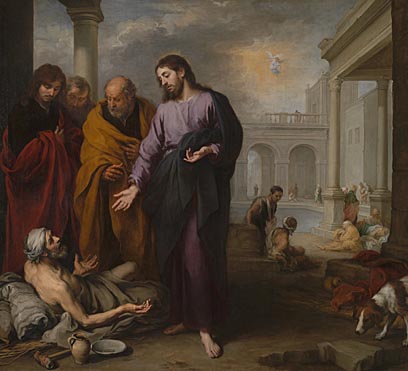 The Pool of Bethesda ~ written by M. Basilea Schlink
The Pool of Bethesda ~ written by M. Basilea Schlink
excerpt from THE HOLY LAND TODAY
copyright 1975 Evangelical Sisterhood of Mary www.kanaan-canada.org
used by permission
The Historical Aspect
The Pool of Bethesda is mentioned only in the Gospel of John, chapter five. Later sources sometimes refer to it as the Pool of Bethzatha, naming it after the district in which it lay, a suburb north of theTemple. But the name Bethesda which means “House of Mercy”, predominated. According to John, the pool lay near the Sheep Gate, but it is no longer possible to determine the exact location of the gate. It may have been on the north side of theTemple premises or near the present Lion’s Gate.
The five portices described by John were probably built by Herod the Great; four surrounded the pool, the fifth was upon the wall that divided the pool in two. It was in these porches that the sick waited for the troubling of the waters when they could claim the healing properties of the pool.
The memory of the pool and of the miracle wrought there by jesus persisted. In A.D. 300 the historian Eusibius described the five porches as well as the double pool; likewise the Pilgrim of Bordeaux in 333, his being the earliest pilgrim’s description extant. But according to both of these reports, healings no longer occurred here through the troubling of the aters as they had done in Jesus’ day. With the passing of time, porches deteriorated and the pool was gradually filled in. About A.D. 450 a Church of the Paralytic built on the site is mentioned for the first time, but in the same century a church built in the vicinity to the memory of Mary, over the grotto regarded as her birthplace came to the fore. After the Persians destroyed the church over the pool in 614, it remained in ruins, whereas the Church of St. Mary’s was rebuilt.
In 1100 the Crusaders built a chapel on the site of the pool ofBethesdaand enlarged theChurchofSt. Mary, renaming it in honour of St. Anne. The chapel on the pool was probably destroyed soon after the defeat of the Crusaders in 1187. The pool completely disappeared beneath the ruins and fell into oblivion.
After the Crimean War in 1856 the Turkish sultan gave this site to Naloleon III as an acknowledgement for indebtedness to the French for their assistance. In 1873 traces of the ancient pool were rediscovered. The White Fathers, who now run a Greek Catholic seminary here, acquired the site in 1878. Their excavations, which continually brought new fins to light, witness to the strong possibility that this is the site of the miracle described in John 5.
From the Holy Bible ` John 5:1-14 (New International Version)
Some time later, Jesus went up to Jerusalemfor one of the Jewish festivals. 2 Now there is in Jerusalem near the Sheep Gate a pool, which in Aramaic is called Bethesda[a] and which is surrounded by five covered colonnades. 3 Here a great number of disabled people used to lie—the blind, the lame, the paralyzed. [4] [b] 5 One who was there had been an invalid for thirty-eight years. 6 When Jesus saw him lying there and learned that he had been in this condition for a long time, he asked him, “Do you want to get well?” 7 “Sir,” the invalid replied, “I have no one to help me into the pool when the water is stirred. While I am trying to get in, someone else goes down ahead of me.” 8 Then Jesus said to him, “Get up! Pick up your mat and walk.” 9 At once the man was cured; he picked up his mat and walked. The day on which this took place was a Sabbath, 10 and so the Jewish leaders said to the man who had been healed, “It is the Sabbath; the law forbids you to carry your mat.” 11 But he replied, “The man who made me well said to me, ‘Pick up your mat and walk.’ ” 12 So they asked him, “Who is this fellow who told you to pick it up and walk?”13 The man who was healed had no idea who it was, for Jesus had slipped away into the crowd that was there. 14 Later Jesus found him at the temple and said to him, “See, you are well again. Stop sinning or something worse may happen to you.”
The Pool of Bethesda
A Message for Us
Once again Jesus was in Jerusalem probably for the Festival of Purim. And where was He drawn? To the place where so many of the sick, the blind, and the crippled lay – to people who lived under the shadow of adversity and severe suffering having many infirmities to bear. Jesus’ heart went out to these poorest of the poor, for He is a Saviour and Physician for His children. And therefore He was especially drawn to the cripple who probably had the heaviest burden of all, since he had lain there ailing for thirty-eight years without receiving any help.
Why did this particular sick man have no one to carry him to the water, although others could find people who were willing to perform this service for them? Jesus’ words after he healed the man, “Sin no more” , seem to indicate that the man’s sickness was connected with his sin. The additional burden of having no one to help him may have been due to his sin as well. And perhaps he had an unpleasant personality. Apparently no one wished to associate with him; he was most likely left to his misery, because people thought, ”He deserves it.”
But now Jesus singles out this man. His arm reaches down to the depths where a person is sunk in sin and misery. He rejects no one, although He is God and has every right to cast off sinners. Our human love soon reaches its limit. It ceases when others are nasty and act badly, when they appear to be unworthy of our love. But there is no limit to Jesus’ love. It never ceases, because He is the very essence of love, which has the divine quality of being boundless and all embracing. It is this love that moves Jesus, our Saviour and Healer, to minister to this man in his severe physical need, and thus also in his even greater spiritual need, his sin. Approaching him, Jesus speaks the powerful, almost incredible words, “Take up your bed and walk.” How can an incurably sick man rise, take up his bed and walk? Yet to everyone’s astonishment this is precisely what happens.
The Pharisees scold the sick man, saying, “It is not lawful to carry your bed on the Sabbath.” Their reaction is typical of human nature in its limited love. Rules and regulations are given precedence to love. When the cripple, overjoyed that he can move his limbs again after thirty-eight years of illness, carries his bed home, the Pharisees rebuke the man as if he were committing some wrong. Yet despite all their criticism they cannot give him the correction he so needs. They cannot tell him the truth about himself and his sinas Jesus does; they lack the authority of love that canhelp bring sinners to repentance through a work of truth.
How different from the Pharisees does Jesus address sinners, the poor and sick! How differently He acts in their lives. Truly, as high as the heavens are above the earth, so different is His judgement from our judgement, His words from ours, His help from that which we show one another. Jesus addresses the healed man with words that have retained their power to this day, piercing the hearts of all who hear them, “Sin no more, that nothing worse befall you.”
Jesus saving, healing love first helps this man, who has been chastened for thirty-eight years, by healing him, for the Saviour’s heart suffers with the cripple and untold misery of those long years. But true love does not stop there; it sees even deeper. It perceives that the real misery of this person’s lifeis nothis illness and all the hardship and pain involved, but rather his evil, sinful heart, which would bring him torment even in eternity. Accordingly, Jesus deals with the sick man’s sin, so that he might truly be healed, having been released from his sin. Then as a new creation he will be able to live in the Kingdom of God for eternity. God’s goodness, which brought this man relief from his ailment and misery, is meant to lead him to repentance. Therefore, God’s goodness and Jesus’ act of loving-kindness to the cripple are accompanied by words of truth. This is what lies behind Jesus’ words, “Sin no more, that nothing worse befall you.”
Jesus helps this sick man, but after relieving him of his burden, He admonishes him. In His love Jesus does not want to chasten the man even more severely, as He would have to do if the man trampled underfoot the goodness of God and fell into even greater sin after his healing. No, in His love Jesus yearns for this man to lead a new life and to find true health and happiness without having to undergo further severe chastening.
This ministering love of Jesus was meant not only for the sick man long ago; it is available for us today. When we visit the ruins of the Pool of Bethesda, it is as if Jesus is waiting for us here today as our loving Saviour and Physician, so that we too may experience His goodness in body and soul. When we are sunk in misery and distress with no one to help us, He has the power to help us. By placing ourselves in His hands, we entrust ourselves to His true love, which seeks not only to heal our bodies, but to minister to our souls. Therefore, Jesus also bids us to take care that we turn from our sins and lead a life of thanksgiving and commitment to Him in response to the goodness and help He has shown us in our troubles. Jesus asks us to make a fresh start today, so that He does not have to chasten us more severely. Truly, in His love He longs to help us, so that we shall be made whole for all eternity.




